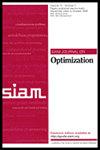通用图上正交同步的低维松弛的良性景观
IF 2.3
1区 数学
Q1 MATHEMATICS, APPLIED
引用次数: 0
摘要
SIAM 优化期刊》,第 34 卷第 2 期,第 1427-1454 页,2024 年 6 月。摘要正交群同步是在给定一些相对测量值[数学]的情况下,从[数学]正交群中估计[数学]元素[数学]的问题。最小二乘公式是非凸的。为了避免出现局部极小值,肖尔型凸松弛将优化问题的维度从[数学]平方到[数学]。另外,Burer-Monteiro 类型的非凸松弛在维数 [math] 时有一般景观保证。对于较小的松弛,问题结构很重要。根据机器人学文献的观察,对于同时存在的定位和映射问题,似乎只需将维度提高到原来的一个小常数倍数即可。我们将对此做出部分解释。这对仓本振荡器也有影响。具体来说,我们要最小化估计器[math]的最小二乘成本函数。对于[math],每个[math]都被放宽到具有正交行的[math]矩阵的 Stiefel 流形[math]。可用的测量值隐含地定义了[math]顶点上的[math](连通)图。在无噪声情况下,我们证明,对于所有连通图[math],只要[math]的二阶临界点是全局最优的。(这意味着[math]上的仓本振荡器对所有[math]都是同步的)。这个结果是一般图的最佳结果;之前已知的最佳结果需要 [math]。对于 [math],我们的结果对适量噪声(取决于 [math] 和 [math])是稳健的。我们的证明使用了一种新颖的随机选择切线方向的方法来证明二阶临界点的(近)最优性。最后,我们将无噪声景观结果部分扩展到复数情况(单元群);我们证明了当 [math].本文章由计算机程序翻译,如有差异,请以英文原文为准。
Benign Landscapes of Low-Dimensional Relaxations for Orthogonal Synchronization on General Graphs
SIAM Journal on Optimization, Volume 34, Issue 2, Page 1427-1454, June 2024.
Abstract. Orthogonal group synchronization is the problem of estimating [math] elements [math] from the [math] orthogonal group given some relative measurements [math]. The least-squares formulation is nonconvex. To avoid its local minima, a Shor-type convex relaxation squares the dimension of the optimization problem from [math] to [math]. Alternatively, Burer–Monteiro-type nonconvex relaxations have generic landscape guarantees at dimension [math]. For smaller relaxations, the problem structure matters. It has been observed in the robotics literature that, for simultaneous localization and mapping problems, it seems sufficient to increase the dimension by a small constant multiple over the original. We partially explain this. This also has implications for Kuramoto oscillators. Specifically, we minimize the least-squares cost function in terms of estimators [math]. For [math], each [math] is relaxed to the Stiefel manifold [math] of [math] matrices with orthonormal rows. The available measurements implicitly define a (connected) graph [math] on [math] vertices. In the noiseless case, we show that, for all connected graphs [math], second-order critical points are globally optimal as soon as [math]. (This implies that Kuramoto oscillators on [math] synchronize for all [math].) This result is the best possible for general graphs; the previous best known result requires [math]. For [math], our result is robust to modest amounts of noise (depending on [math] and [math]). Our proof uses a novel randomized choice of tangent direction to prove (near-)optimality of second-order critical points. Finally, we partially extend our noiseless landscape results to the complex case (unitary group); we show that there are no spurious local minima when [math].
Abstract. Orthogonal group synchronization is the problem of estimating [math] elements [math] from the [math] orthogonal group given some relative measurements [math]. The least-squares formulation is nonconvex. To avoid its local minima, a Shor-type convex relaxation squares the dimension of the optimization problem from [math] to [math]. Alternatively, Burer–Monteiro-type nonconvex relaxations have generic landscape guarantees at dimension [math]. For smaller relaxations, the problem structure matters. It has been observed in the robotics literature that, for simultaneous localization and mapping problems, it seems sufficient to increase the dimension by a small constant multiple over the original. We partially explain this. This also has implications for Kuramoto oscillators. Specifically, we minimize the least-squares cost function in terms of estimators [math]. For [math], each [math] is relaxed to the Stiefel manifold [math] of [math] matrices with orthonormal rows. The available measurements implicitly define a (connected) graph [math] on [math] vertices. In the noiseless case, we show that, for all connected graphs [math], second-order critical points are globally optimal as soon as [math]. (This implies that Kuramoto oscillators on [math] synchronize for all [math].) This result is the best possible for general graphs; the previous best known result requires [math]. For [math], our result is robust to modest amounts of noise (depending on [math] and [math]). Our proof uses a novel randomized choice of tangent direction to prove (near-)optimality of second-order critical points. Finally, we partially extend our noiseless landscape results to the complex case (unitary group); we show that there are no spurious local minima when [math].
求助全文
通过发布文献求助,成功后即可免费获取论文全文。
去求助
来源期刊

SIAM Journal on Optimization
数学-应用数学
CiteScore
5.30
自引率
9.70%
发文量
101
审稿时长
6-12 weeks
期刊介绍:
The SIAM Journal on Optimization contains research articles on the theory and practice of optimization. The areas addressed include linear and quadratic programming, convex programming, nonlinear programming, complementarity problems, stochastic optimization, combinatorial optimization, integer programming, and convex, nonsmooth and variational analysis. Contributions may emphasize optimization theory, algorithms, software, computational practice, applications, or the links between these subjects.
 求助内容:
求助内容: 应助结果提醒方式:
应助结果提醒方式:


